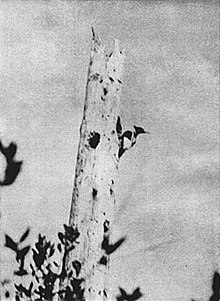Cuban ivory-billed woodpecker
| Cuban ivory-billed woodpecker | |
|---|---|
 |
|
| A male Cuban Ivory-Bill, photo by John Dennis | |
| Scientific classification | |
| Kingdom: | Animalia |
| Phylum: | Chordata |
| Class: | Aves |
| Order: | Piciformes |
| Family: | Picidae |
| Genus: | Campephilus |
| Species: | C. principalis (? see text) |
| Subspecies: | C. p. bairdii |
| Trinomial name | |
|
Campephilus principalis bairdii (Cassin, 1863) |
|
The Cuban ivory-billed woodpecker or carpintero real (Campephilus principalis bairdii) is, or was, a Cuban subspecies of the ivory-billed woodpecker (Campephilus principalis). Once classified as a separate species, recent research has indicated that C. p. bairdii may in fact be sufficiently distinct from the nominate to once again be regarded as a species in its own right.
No specimens have been seen since 1987, and it is now considered to be extinct.
C. p. bairdii, originally designated a separate species (Campephilus bairdii) by John Cassin based on suggestions by Spencer Fullerton Baird, was similar in appearance to the American birds, being slightly smaller and having minor variations in plumage such as a longer white stripe on the head. A more recent study by Fleischer, Kirchman et al. has however suggested that not only are the Cuban and American forms genetically distinct, but also that they and the imperial woodpecker form a distinct North American clade within Campephilus that appeared in the Mid-. The methods adopted by the study suggest that the split between C. principalis and the lineage represented by C. p. bairdii and C. imperialis occurred first, and that all three birds should be regarded as representing distinct species. The American Ornithologists' Union Committee on Classification and Nomenclature, while describing the data as "intriguing", has indicated that it is not yet ready to list the American and Cuban forms as two separate species.
Cassin described the species as:
Much resembling C. principalis, but smaller and with the black anterior feathers of the crest longer than those succeeding, which are scarlet. White longitudinal line on the neck reaching quite to the base of the bill. [...] It appears to be one of the singular insular species which have become well known to naturalists.
The first detailed description of the Cuban form's behaviour and habitat was not published until 1893, when Juan Gundlach included it in Volume 1 of his Ornitología Cubana. In Cuba it was usually known by the name of carpintero real (royal woodpecker), although this name was also used for other birds.
...
Wikipedia

